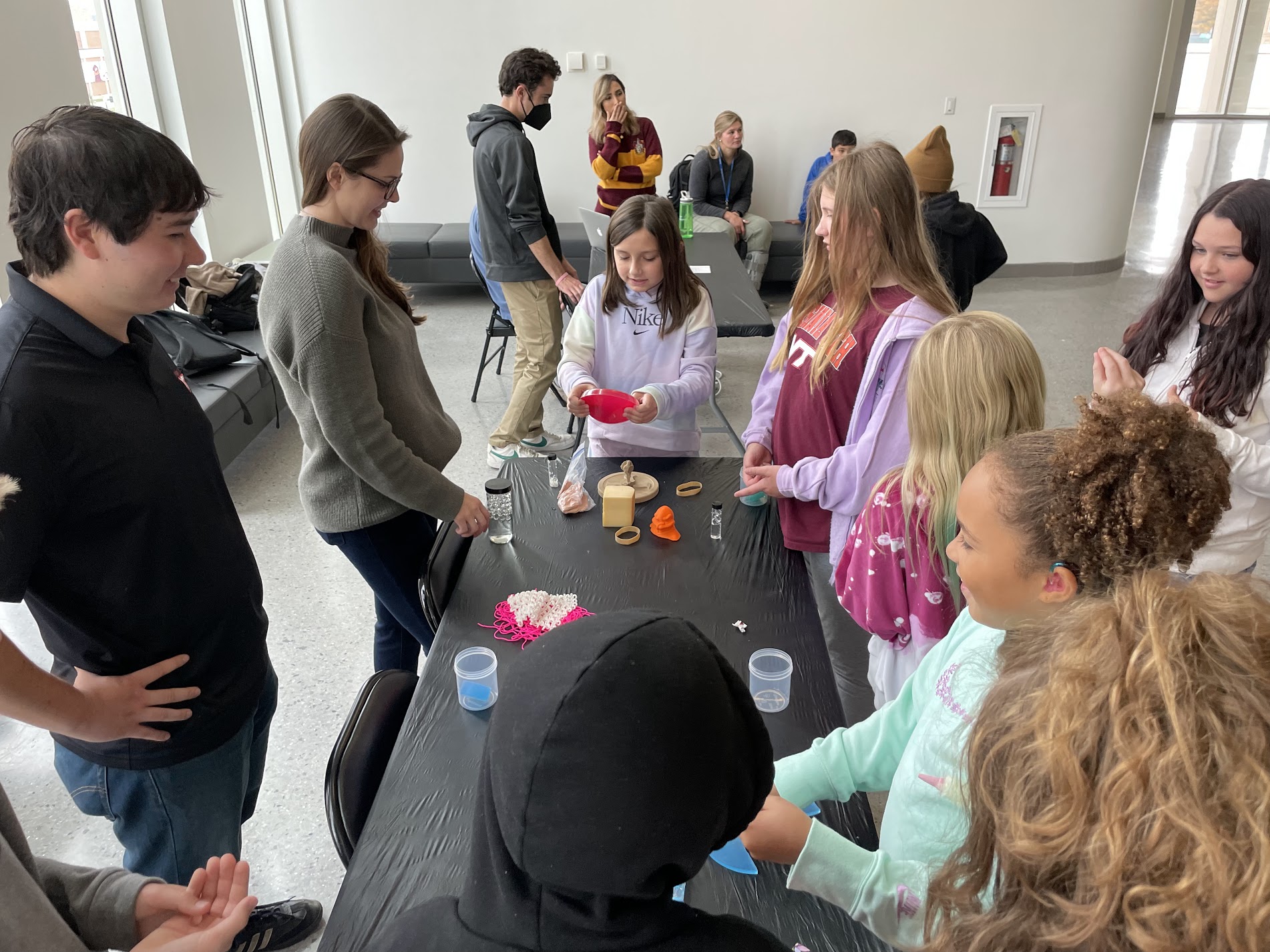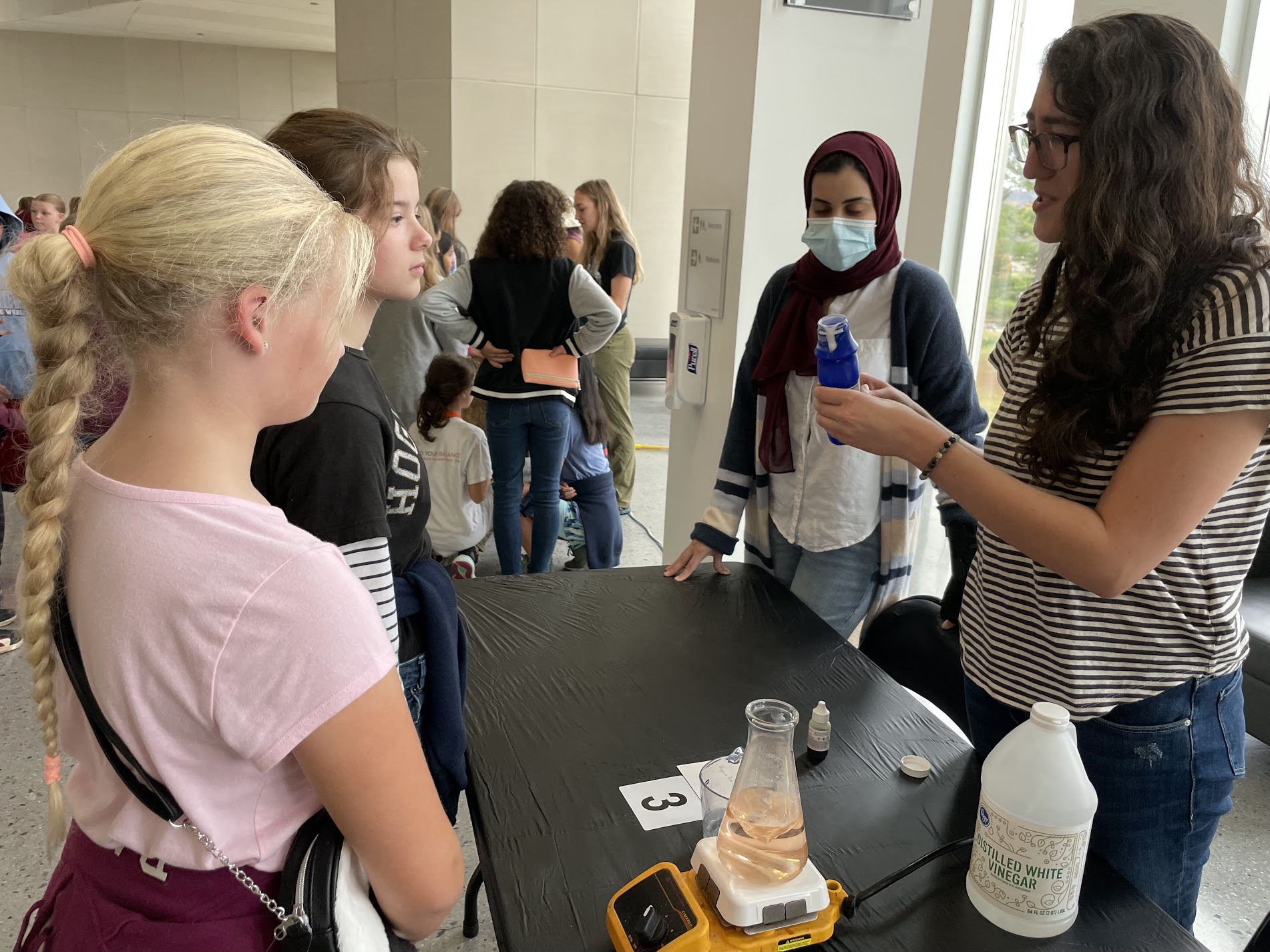Communicating Science Students Share Their Research With 5th, 6th, and 7th Graders
December 12, 2022

"It was a great experience presenting our research to the fifth graders," said Eddah Mauti, a graduate student in industrial and systems engineering. "I loved interacting with the different groups and adjusting our presentation to suit the different group personalities."
Mauti, who talked to 60 fifth graders from Prices Fork Elementary School about self-driving vehicles and pedestrian traffic safety, was describing an October 26 event, when she worked with 17 other graduate students in her Communicating Science course (GRAD 5144) to share their research through the Hokie for a Day Expo at the Moss Arts Center.

Participation in an outreach event has been a key component of Communicating Science since the course’s beginnings in 2012. Developed by Patty Raun, director of the Center for Communicating Science, the 2-credit graduate-level Communicating Science course uses tools from the performing arts to help researchers learn to communicate their work clearly and effectively.
Hokie for a Day, which evolved from a program called Kindergarten to College started by now-retired professor of educational psychology Susan Magliaro, is run by Phyllis Newbill, associate director of educational networks for the Center for Educational Networks and Impacts (CENI). The program brings groups of fifth graders from Title 1 schools to Virginia Tech for a brief experience of campus life. During their visit, students eat in a campus dining hall, talk to a student athlete, interact with faculty and students at the Moss Arts Center expo, and learn about college majors and pathways to college. Newbill is already recruiting exhibitors for spring semester; you can sign up at the Hokie for a Day exhibitor page.
Last spring was the first time Communicating Science students participated in one of the weekly Hokie for a Day Expos, and it proved to be a great experience for the graduate students as well as for the fifth graders, as it was again this fall.
The second section of Communicating Science students this fall traveled to Eastern Elementary/Middle School in Giles County, where the class has been visiting every semester since 2016 — including virtual visits during the early years of the COVID-19 pandemic.

For some graduate students, the trip to Eastern presents their first opportunity to visit an American public school.
“I was nervous and excited at the same time because it was my first time visiting a middle school in the United States,” said geosciences graduate student Asenath Kwagalakwe. “My experience with the kids was great. They were excited to see us.”

The graduate students learn a great deal from the experience regardless of the location of their outreach.
"I had so much fun with the kids this week at Hokie for a Day,” said Karen Williams, also a geosciences graduate student. “It was interesting how differently all of the kids responded to the presentation. Some were clearly interested in the science and actually knew a lot more than I was expecting. Then there were other students who mostly just wanted to play with the flour. There were even one or two questions that I wasn’t sure of.”
Williams found that the model she brought, which uses a big tub of flour to show how pressure builds up beneath the earth’s surface to create rifts and volcanic eruptions, was a great attractant for the children. But she also put some of her communicating science training into action.
“I felt I improved in my ability to explain my field since I had to be very conscious of not using complicated explanations,” she said. “I also had to think of examples that these kids could understand and relate to."

Environmental engineering graduate student Frank Mazzola brought some water samples to the Hokie for a Day Expo to explain how corrosive water can leach lead out of old plumbing joints and into drinking water.
“I do not have very much experience dealing with kids in general, let alone to discuss scientific research, so it was a good experience to bring me out of my comfort zone with this activity," he commented. “It is a good experience for graduate students, researchers, scientists, etc. to be challenged with explaining their research to such an audience.”
Kwagalakwe appreciated collaborating with others in her course section to plan and implement their presentation for the middle school students in Giles County. She also enjoyed the visit, during which all the kids were dressed in pajamas, for other reasons: “I got to learn about the culture of middle school, including things like Pajama Day, gym hour, etc. I enjoyed myself.”
Students who enroll in Communicating Science see a variety of reasons to engage in outreach.

"I hope that they [the fifth graders] left with a positive impression of the different career paths in science at Virginia Tech and elsewhere,” said Mazzola. “I think that outreach events like this are important to help encourage students to be interested in science, higher education, etc.”
Experiential learning is the core of the Communicating Science course, and developing a short presentation, demonstration, or hands-on activity for a live audience is part of that experiential learning. Over the years, Communicating Science students also have shared their research with residents of the Warm Hearth Retirement Community, honors students in the East Ambler-Johnston honors community, and students in a Leadership in Science course.


